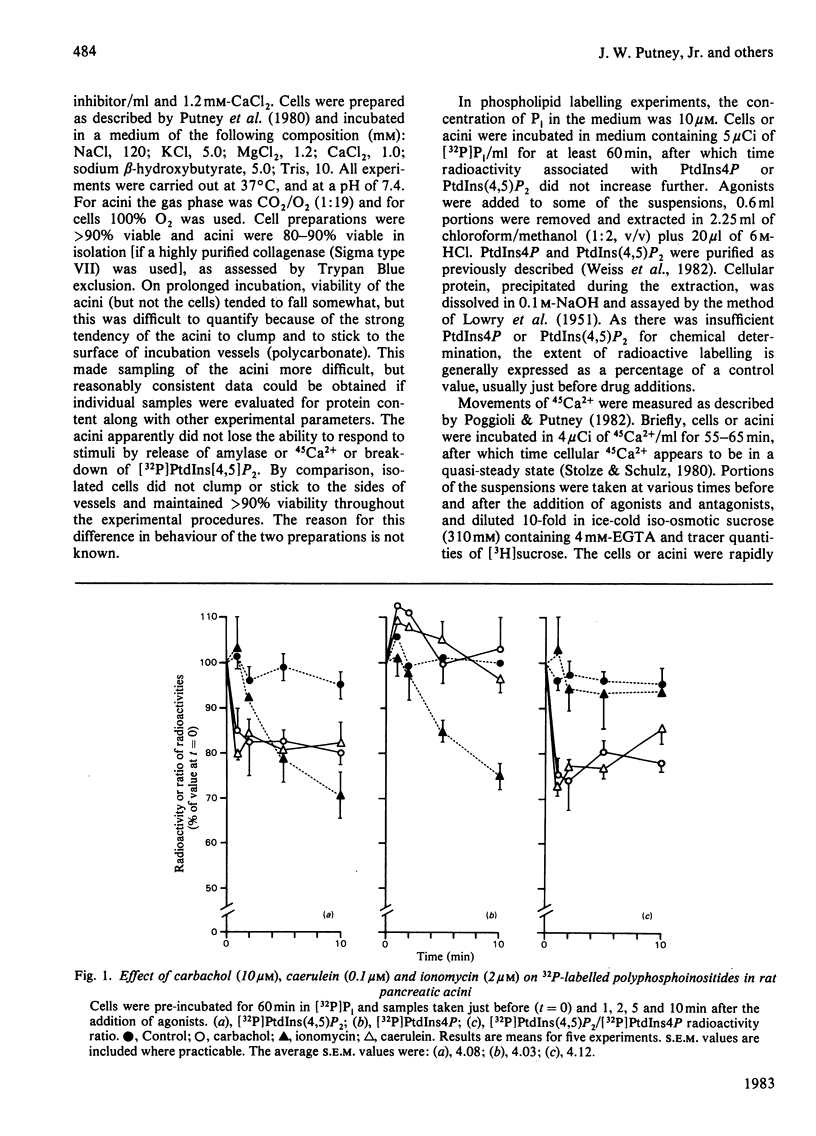Abstract
Experiments were carried out to assess the effects of secretagogues on the polyphosphoinositides phosphatidylinositol 4-phosphate (PtdIns4P) and phosphatidylinositol 4,5-bisphosphate [PtdIns(4,5)P2] on preparations of exocrine pancreas in vitro. Carbachol and caerulein provoked a rapid (less than 1 min) breakdown of 15-20% of [32P]PtdIns(4,5)P2 in isolated pancreatic acini, but did not affect [32P]PtdIns4P. In contrast, the Ca2+ ionophore ionomycin had no immediate effect on the levels of either inositide but caused a parallel fall in both lipids after 5-10 min. A similar decrease in [32P]PtdIns(4,5)P2 due to carbachol was obtained with isolated acini and isolated cells, despite the fact that the secretory response of isolated cells was considerably less than that of isolated acini. Loss of [32P]PtdIns(4,5)P2 elicited by carbachol or caerulein was unaffected either by the addition of EGTA in excess of extracellular Ca2+ or when a protocol was employed that eliminated caerulein-induced intracellular Ca2+-release. These results suggest that agonist-induced PtdIns(4,5)P2 breakdown in the exocrine pancreas may be an early step in the stimulus-response coupling pathway and also suggest that this breakdown is not dependent on Ca2+-mobilization.
Full text
PDF





Selected References
These references are in PubMed. This may not be the complete list of references from this article.
- Abdel-Latif A. A., Akhtar R. A., Hawthorne J. N. Acetylcholine increases the breakdown of triphosphoinositide of rabbit iris muscle prelabelled with [32P] phosphate. Biochem J. 1977 Jan 15;162(1):61–73. doi: 10.1042/bj1620061. [DOI] [PMC free article] [PubMed] [Google Scholar]
- Akhtar R. A., Abdel-Latif A. A. Calcium ion requirement for acetylcholine-stimulated breakdown of triphosphoinositide in rabbit iris smooth muscle. J Pharmacol Exp Ther. 1978 Mar;204(3):655–668. [PubMed] [Google Scholar]
- Billah M. M., Lapetina E. G. Rapid decrease of phosphatidylinositol 4,5-bisphosphate in thrombin-stimulated platelets. J Biol Chem. 1982 Nov 10;257(21):12705–12708. [PubMed] [Google Scholar]
- Farese R. V., Larson R. E., Sabir M. A. Ca2+-dependent and Ca2+-independent effects of pancreatic secretagogues on phosphatidylinositol metabolism. Biochim Biophys Acta. 1982 Mar 12;710(3):391–399. doi: 10.1016/0005-2760(82)90122-9. [DOI] [PubMed] [Google Scholar]
- HOKIN M. R., HOKIN L. E. Enzyme secretion and the incorporation of P32 into phospholipides of pancreas slices. J Biol Chem. 1953 Aug;203(2):967–977. [PubMed] [Google Scholar]
- Halenda S. P., Rubin R. P. Phospholipid turnover in isolated rat pancreatic acini. Consideration of the relative roles of phospholipase A2 and phospholipase C. Biochem J. 1982 Dec 15;208(3):713–721. doi: 10.1042/bj2080713. [DOI] [PMC free article] [PubMed] [Google Scholar]
- Hawthorne J. N. Is phosphatidylinositol now out of the calcium gate? Nature. 1982 Jan 28;295(5847):281–282. doi: 10.1038/295281a0. [DOI] [PubMed] [Google Scholar]
- Kirk C. J., Creba J. A., Downes C. P., Michell R. H. Hormone-stimulated metabolism of inositol lipids and its relationship to hepatic receptor function. Biochem Soc Trans. 1981 Oct;9(5):377–379. doi: 10.1042/bst0090377. [DOI] [PubMed] [Google Scholar]
- Marshall P. J., Boatman D. E., Hokin L. E. Direct demonstration of the formation of prostaglandin E2 due to phosphatidylinositol breakdown associated with stimulation of enzyme secretion in the pancreas. J Biol Chem. 1981 Jan 25;256(2):844–847. [PubMed] [Google Scholar]
- Michell R. H. Inositol phospholipids and cell surface receptor function. Biochim Biophys Acta. 1975 Mar 25;415(1):81–47. doi: 10.1016/0304-4157(75)90017-9. [DOI] [PubMed] [Google Scholar]
- Michell R. H., Kirk C. J., Jones L. M., Downes C. P., Creba J. A. The stimulation of inositol lipid metabolism that accompanies calcium mobilization in stimulated cells: defined characteristics and unanswered questions. Philos Trans R Soc Lond B Biol Sci. 1981 Dec 18;296(1080):123–138. doi: 10.1098/rstb.1981.0177. [DOI] [PubMed] [Google Scholar]
- Poggioli J., Putney J. W., Jr Net calcium fluxes in rat parotid acinar cells: evidence for a hormone-sensitive calcium pool in or near the plasma membrane. Pflugers Arch. 1982 Jan;392(3):239–243. doi: 10.1007/BF00584303. [DOI] [PubMed] [Google Scholar]
- Poggioli J., Weiss S. J., McKinney J. S., Putney J. W., Jr Effects of antimycin A on receptor-activated calcium mobilization and phosphoinositide metabolism in rat parotid gland. Mol Pharmacol. 1983 Jan;23(1):71–77. [PubMed] [Google Scholar]
- Putney J. W., Jr, Landis C. A., van de Walle C. M. Effect of carbachol on radiosodium uptake by dispersed pancreatic acinar cells. Pflugers Arch. 1980 May;385(2):131–136. doi: 10.1007/BF00588692. [DOI] [PubMed] [Google Scholar]
- Stolze H., Schulz I. Effect of atropine, ouabain, antimycin A, and A23187 on "trigger Ca2+ pool" in exocrine pancreas. Am J Physiol. 1980 Apr;238(4):G338–G348. doi: 10.1152/ajpgi.1980.238.4.G338. [DOI] [PubMed] [Google Scholar]
- Weiss S. J., McKinney J. S., Putney J. W., Jr Receptor-mediated net breakdown of phosphatidylinositol 4,5-bisphosphate in parotid acinar cells. Biochem J. 1982 Sep 15;206(3):555–560. doi: 10.1042/bj2060555. [DOI] [PMC free article] [PubMed] [Google Scholar]
- Williams J. A. Regulation of pancreatic acinar cell function by intracellular calcium. Am J Physiol. 1980 Apr;238(4):G269–G279. doi: 10.1152/ajpgi.1980.238.4.G269. [DOI] [PubMed] [Google Scholar]


